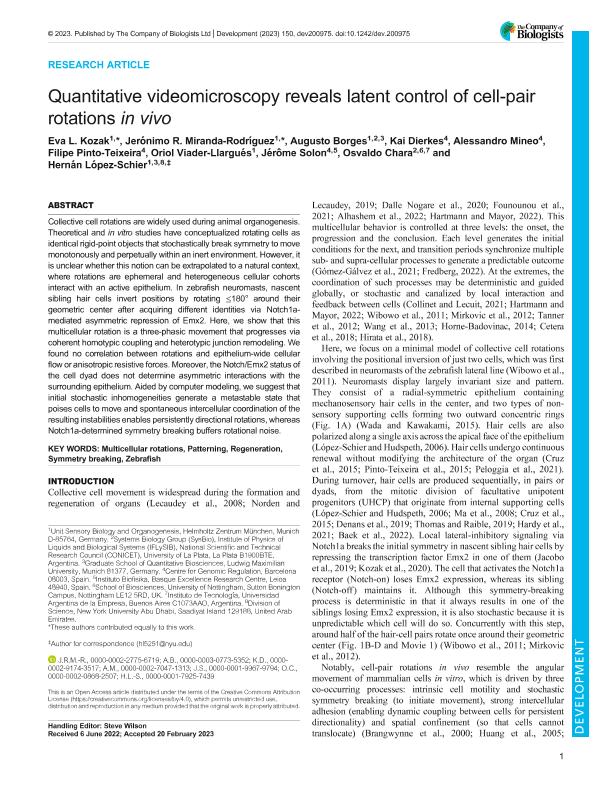Mostrar el registro sencillo del ítem
dc.contributor.author
Kozak, Eva L.
dc.contributor.author
Miranda Rodríguez, Jerónimo R.
dc.contributor.author
Borges, Augusto

dc.contributor.author
Dierkes, Kai
dc.contributor.author
Mineo, Alessandro
dc.contributor.author
Pinto-Teixeira, Filipe
dc.contributor.author
Viader Llargués, Oriol
dc.contributor.author
Solon, Jérôme
dc.contributor.author
Chara, Osvaldo

dc.contributor.author
López Schier, Hernán
dc.date.available
2024-03-25T17:40:35Z
dc.date.issued
2023-05
dc.identifier.citation
Kozak, Eva L.; Miranda Rodríguez, Jerónimo R.; Borges, Augusto; Dierkes, Kai; Mineo, Alessandro; et al.; Quantitative videomicroscopy reveals latent control of cell-pair rotations in vivo; Company of Biologists Ltd; Development (Cambridge); 150; 9; 5-2023; 1-20
dc.identifier.issn
1477-9129
dc.identifier.uri
http://hdl.handle.net/11336/231519
dc.description.abstract
Collective cell rotations are widely used during animal organogenesis. Theoretical and in vitro studies have conceptualized rotating cells as identical rigid-point objects that stochastically break symmetry to move monotonously and perpetually within an inert environment. However, it is unclear whether this notion can be extrapolated to a natural context, where rotations are ephemeral and heterogeneous cellular cohorts interact with an active epithelium. In zebrafish neuromasts, nascent sibling hair cells invert positions by rotating ≤180° around their geometric center after acquiring different identities via Notch1amediated asymmetric repression of Emx2. Here, we show that this multicellular rotation is a three-phasic movement that progresses via coherent homotypic coupling and heterotypic junction remodeling. We found no correlation between rotations and epithelium-wide cellular flow or anisotropic resistive forces. Moreover, the Notch/Emx2 status of the cell dyad does not determine asymmetric interactions with the surrounding epithelium. Aided by computer modeling, we suggest that initial stochastic inhomogeneities generate a metastable state that poises cells to move and spontaneous intercellular coordination of the resulting instabilities enables persistently directional rotations, whereas Notch1a-determined symmetry breaking buffers rotational noise.
dc.format
application/pdf
dc.language.iso
eng
dc.publisher
Company of Biologists Ltd

dc.rights
info:eu-repo/semantics/openAccess
dc.rights.uri
https://creativecommons.org/licenses/by-nc-sa/2.5/ar/
dc.subject
MULTICELLULAR ROTATIONS
dc.subject
PATTERNING
dc.subject
REGENERATION
dc.subject
SYMMETRY BREAKING
dc.subject
ZEBRAFISH
dc.subject.classification
Biología del Desarrollo

dc.subject.classification
Ciencias Biológicas

dc.subject.classification
CIENCIAS NATURALES Y EXACTAS

dc.title
Quantitative videomicroscopy reveals latent control of cell-pair rotations in vivo
dc.type
info:eu-repo/semantics/article
dc.type
info:ar-repo/semantics/artículo
dc.type
info:eu-repo/semantics/publishedVersion
dc.date.updated
2024-03-11T11:59:29Z
dc.journal.volume
150
dc.journal.number
9
dc.journal.pagination
1-20
dc.journal.pais
Reino Unido

dc.description.fil
Fil: Kozak, Eva L.. Helmholtz Center Munich German Research Center For Environmental Health; Alemania
dc.description.fil
Fil: Miranda Rodríguez, Jerónimo R.. Helmholtz Center Munich German Research Center For Environmental Health; Alemania
dc.description.fil
Fil: Borges, Augusto. Consejo Nacional de Investigaciones Científicas y Técnicas. Centro Científico Tecnológico Conicet - La Plata. Instituto de Física de Líquidos y Sistemas Biológicos. Universidad Nacional de La Plata. Facultad de Ciencias Exactas. Instituto de Física de Líquidos y Sistemas Biológicos; Argentina. Ludwig Maximilians Universitat; Alemania. Helmholtz Center Munich German Research Center For Environmental Health; Alemania
dc.description.fil
Fil: Dierkes, Kai. Centro de Regulación Genómica; España
dc.description.fil
Fil: Mineo, Alessandro. Centro de Regulación Genómica; España
dc.description.fil
Fil: Pinto-Teixeira, Filipe. Centro de Regulación Genómica; España
dc.description.fil
Fil: Viader Llargués, Oriol. Helmholtz Center Munich German Research Center For Environmental Health; Alemania
dc.description.fil
Fil: Solon, Jérôme. Centro de Regulación Genómica; España
dc.description.fil
Fil: Chara, Osvaldo. Universidad Argentina de la Empresa; Argentina. University of Nottingham; Estados Unidos. Science and Technology Facilities Council of Nottingham. Rutherford Appleton Laboratory; Reino Unido. Consejo Nacional de Investigaciones Científicas y Técnicas. Centro Científico Tecnológico Conicet - La Plata. Instituto de Física de Líquidos y Sistemas Biológicos. Universidad Nacional de La Plata. Facultad de Ciencias Exactas. Instituto de Física de Líquidos y Sistemas Biológicos; Argentina
dc.description.fil
Fil: López Schier, Hernán. New York University Abu Dhabi; Emiratos Arabes Unidos. Ludwig Maximilians Universitat; Alemania. Helmholtz Center Munich German Research Center For Environmental Health; Alemania
dc.journal.title
Development (Cambridge)

dc.relation.alternativeid
info:eu-repo/semantics/altIdentifier/doi/http://dx.doi.org/10.1242/dev.200975
dc.relation.alternativeid
info:eu-repo/semantics/altIdentifier/url/https://journals.biologists.com/dev/article/150/9/dev200975/306245/Quantitative-videomicroscopy-reveals-latent
Archivos asociados
